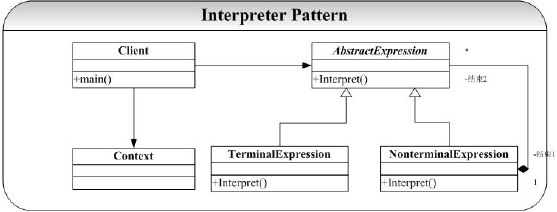尊重原创,本系列文本解析部分主要基于Candidate for Master’s Degree School of Computer Wuhan University的K_Eckel([email protected] )《设计模式精解-GoF 23 种设计模式解析附 C++实现源码》。为了避免重造轮子,本系列博文对源码在ubuntu16.04下做了验证并上传到了gitee ,再次感谢。
如有问题,可邮件联系我([email protected]
Factory 模式 | AbstactFactory 模式 | Singleton 模式 | Builder 模式 | Prototype 模式
Bridge 模式 | Adapter 模式 | Decorator 模式 | Composite 模式 | Flyweight 模式 | Facade 模式 | Proxy 模式
Template 模式 | Strategy 模式 | State 模式 | Observer 模式 | Memento 模式 | Mediator 模式 | Command 模式 | Visitor 模式 | Iterator 模式 | Interpreter 模式 | Chain of Responsibility 模式
解释器模式(Interpreter Pattern)提供了评估语言的语法或表达式的方式,它属于行为型模式。这种模式实现了一个表达式接口,该接口解释一个特定的上下文。这种模式被用在 SQL 解析、符号处理引擎等。比如一些重复出现的问题可以用一种简单的语言来进行表达。
一些应用提供了内建(Build-In)的脚本或者宏语言来让用户可以定义他们能够在系统中进行的操作。Interpreter模式的目的就是使用一个解释器为用户提供一个一门定义语言的语法表示的解释器,然后通过这个解释器来解释语言中的句子。
解释器模式典型的结构图为:
Interpreter模式中,提供了TerminalExpression和NonterminalExpression两种表达式的解释方式,Context类用于为解释过程提供一些附加的信息(例如全局的信息)。
Interpreter模式的实现比较简单,这里为了方便初学者的学习和参考,将给出完整的实现代码(所有代码采用 C++实现,并在 Visual Studio Code,Version: 1.36.1 下测试运行)。
源码gitee地址:点击这里
代码目录结构:
1 2 3 4 5 6 7 8 9 10 11 12 13 14 15 PS C:\Users\guopz\Desktop\GiteeBlog\designpatternsbycpipei\behavioralPattern\Interpreter> tree /F 卷 Windows 的文件夹 PATH 列表 卷序列号为 F0C5-AFA6 C:. ├─include │ Context.h │ Interpret.h │ └─src a.out Context.cpp Interpret.cpp main.cpp PS C:\Users\guopz\Desktop\GiteeBlog\designpatternsbycpipei\behavioralPattern\Interpreter>
Context.h:
1 2 3 4 5 6 7 8 9 10 11 12 13 14 15 16 // Context.h #ifndef _CONTEXT_H_ #define _CONTEXT_H_ class Context { public: Context(); ~Context(); protected: private: }; #endif //~_CONTEXT_H_
Interpret.h:
1 2 3 4 5 6 7 8 9 10 11 12 13 14 15 16 17 18 19 20 21 22 23 24 25 26 27 28 29 30 31 32 33 34 35 36 37 38 39 40 41 //Interpret.h #ifndef _INTERPRET_H_ #define _INTERPRET_H_ #include "Context.h" #include <string> using namespace std; class AbstractExpression{ public: virtual ~AbstractExpression(); virtual void Interpret(const Context& c); protected: AbstractExpression(); private: }; class TerminalExpression:public AbstractExpression{ public: TerminalExpression(const string& statement); ~ TerminalExpression(); void Interpret(const Context& c); protected: private: string _statement; }; class NonterminalExpression:public AbstractExpression{ public: NonterminalExpression(AbstractExpression* expression,int times); ~ NonterminalExpression(); void Interpret(const Context& c); protected: private: AbstractExpression* _expression; int _times; }; #endif //~_INTERPRET_H_
Context.cpp:
1 2 3 4 5 6 // Context.cpp #include "../include/Context.h" Context::Context() {} Context::~Context() {}
Interpret.cpp:
1 2 3 4 5 6 7 8 9 10 11 12 13 14 15 16 17 18 19 20 21 22 23 24 25 // Interpret.cpp #include "../include/Interpret.h" #include <iostream> using namespace std; AbstractExpression::AbstractExpression() {} AbstractExpression::~AbstractExpression() {} void AbstractExpression::Interpret(const Context& c) {} TerminalExpression::TerminalExpression(const string& statement) { this->_statement = statement; } TerminalExpression::~TerminalExpression() {} void TerminalExpression::Interpret(const Context& c) { cout << this->_statement << " TerminalExpression" << endl; } NonterminalExpression::NonterminalExpression(AbstractExpression* expression, int times) { this->_expression = expression; this->_times = times; } NonterminalExpression::~NonterminalExpression() {} void NonterminalExpression::Interpret(const Context& c) { for (int i = 0; i < _times; i++) { this->_expression->Interpret(c); } }
main.cpp:
1 2 3 4 5 6 7 8 9 10 11 12 13 14 15 16 // main.cpp #include <iostream> #include "../include/Context.h" #include "../include/Interpret.h" using namespace std; int main(int argc, char* argv[]) { Context* c = new Context(); AbstractExpression* te = new TerminalExpression("hello"); AbstractExpression* nte = new NonterminalExpression(te, 2); nte->Interpret(*c); return 0; }
Interpreter模式的示例代码很简单,只是为了说明模式的组织和使用,实际的解释Interpret逻辑没有实际提供。
XML格式的数据解析是一个在应用开发中很常见并且有时候是很难处理的事情,虽然目前很多的开发平台、语言都提供了对XML格式数据的解析,但是例如到了移动终端设备上,由于处理速度、计算能力、存储容量的原因解析XML格式的数据却是很复杂的一件事情,最近也提出了很多的移动设备的XML格式解析器,但是总体上在项目开发时候还是需要自己去设计和实现这一个过程(笔者就有过这个方面的痛苦经历)。Flyweight模式 来实现终结符的共享。




